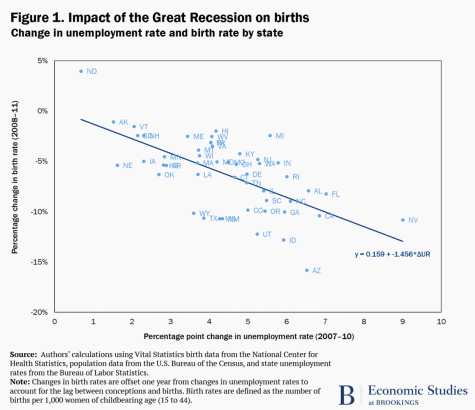
Savannah Gresham | Writer
April 14, 2021
It’s been well past nine months since the end of quarantine—so where are all the babies?
Many thought that the number of sheltered couples with little to do but procreate would bring a tremendous upsurge in the US birth rate, but the research reveals that we’re being faced with quite the opposite. Currently, we are experiencing the deepest decline in births in over 100 years.
This was a startling statistic at first, but it begins to make sense—as most things do—when we examine the past. Turbulent economic conditions and weak labor markets have historically led to declines in birth rates, namely during the Great Depression in the 1930s and, more recently, the Great Recession of 2008.
Studies show that it’s not so much a moral crisis as it is economical. Financial instability has become somewhat of a norm among the younger generations, so really it comes as no surprise that the rates are so rapidly declining when incomes are too. When money is low and stakes are high, couples have to wonder whether a baby is too pricey of an “investment.” Countless would-be mothers and fathers are left to question — do the costs of parenting outweigh the benefits?
“My parents were going to have a baby this year, but they decided to postpone it because of all of the stress of online learning. They’ve been too busy trying to take care of my little sister and me and handle their jobs to really have time to take care of a baby,” sophomore Mariana Hernandez said. Until people feel more confident about the economy and the state of the world, it seems concerns about having children are going to continue.
A survey conducted early in the pandemic by the Guttmacher Institute, a reproductive health research group, foresaw the decline. The survey, published in May 2020, found that about a third of women said they were delaying pregnancy or wanted fewer children because of the pandemic.
Researchers at the Max Planck Institute for Demographic Research also saw this coming, and their findings suggest that there’s no end in sight for the slump until perhaps August. In one study conducted, they looked at the prevalence of Google search terms in the US—like the pregnancy test “Clearblue” or “morning sickness.” From this, they predicted that there would be a 15.2% decline in births between October of 2021 and February, a number that has since been extended until late 2021.

Joshua Wilde, a research scientist who assisted in conducting the study, believes that there is a pattern between recessions, pandemics, a decline in childbirth, and a recovery. “You would imagine that when the first wave ended, everyone would be like, oh boy, you know, time to have all those kids that we were going to have,” he said.
Some are worried that this is all part of a much greater downward trend in births that may lead to future problems with the population. In the future, if there are fewer people of working age, there will be less tax revenue generated to pay for pensions and healthcare for older adults who, in turn, are living longer. There are solutions to this problem – increasing the retirement age, for example, or encouraging immigration—but those have difficult political implications.
Junior Isabella Diaz is not surprised by the fall in numbers. “It makes sense that birth rates are declining,” she said. “Predictability and stability I think would be key to raising a healthy baby, and with so many people having been fired from their jobs…it feels like the American people are thrown a new curveball every other day. People aren’t exactly jumping at the chance to spend more money and time when their hands are already full. The state of the world is so bad that I wouldn’t want to have a child right now anyway.”
Many countries have tried to increase the number of babies born with little success. Once birth rates decline, it isn’t easy to convince women to have more babies.
“After the large recession of 2009, there may have been some rebound but not back up to the level it was,” Professor Philip Cohen, a Professor of Sociology at the University of Maryland, said. “Certainly in the United States, fertility rates never recovered to their pre-recession levels.” Whether the past year’s events will create a lasting downward trend in the population remains uncertain as economic recovery hangs in the balance.

Leave a Reply